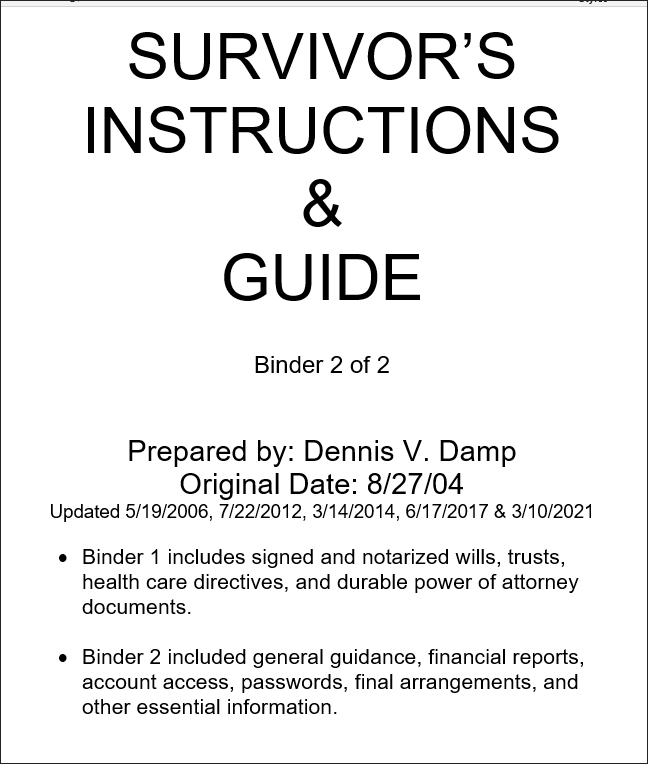Posted on Friday, 14th October 2022 by Dennis Damp
 Print This Post
Print This Post
Please forward this alert to others that may need to review
their beneficiary designations.
A site visitor contacted us about her husband’s untimely death. He died the day before he was scheduled to retire from federal service. His wife was notified by a HR specialist that she might not receive any of her husband’s retirement benefits based on his beneficiary designation form that was submitted back in 1988. They married in 1991.
In 1988 his brother, sister, and mother were assigned as beneficiaries. Her husband completed a new designation of beneficiary form SF-2823 for his Federal Employees Life Insurance (FEGLI) in 1991 that included his new wife. Several months later he competed another designation of beneficiary form that she thought was for his retirement.
She believes her husband made a mistake; instead of changing the beneficiaries for his Federal Employees Retirement System SF-3102, he filled out the same FEGLI form twice.
This can happen with any retirement plan in the civil service or private sectors; issues like this may require hiring an attorney to address the problem.
Retirement Application’s Survivor Annuity Election
More than likely, her husband elected a survivor’s annuity benefit for his wife when he completed his SF-3107 retirement application. HR should provide a copy to his wife that would show the intent of the deceased.
The SF-3107 Application for Immediate Retirement requires the spouses’ consent for a reduced survivor’s annuity. If you are married and don’t elect a reduced annuity to provide a maximum survivor annuity for your current spouse, a spouse must complete Part 2 in the presence of a Notary Public or other person authorized to administer oaths.
OPM Guidance
According to OPM, “If you die while you are an employee and are married, have 18 months of civilian service, and die while you are an active employee, your surviving spouse receives: A lump sum payment plus the higher of 1/2 of your annual pay rate at death or 1/2 of your high-three average pay.”
“The lump sum payment, which increases by cost-of-living adjustments each year. If you had 10 years of service, your spouse also receives an annuity equaling 50% of your accrued basic retirement benefit. These benefits are paid in addition to any Social Security, group life insurance, or savings plan survivor benefits. To be eligible for benefits, you and your spouse must have been married for at least 9 months, or there must be a child born of the marriage, or your death must be accidental.”
Possible Error
In this case, it appears that the employee’s SF-3102 was never updated and the lump sum payment was designated for his family members. However, this form also states under the first paragraph of the instructions, “This designation of beneficiary Form is used to designate who is to receive the lump sum payment which may become payable under the FERS system. It does not affect the right of any person who is eligible for a survivor annuity benefit.” This form is used for Lump Sum payments that may be due at the time of death.
Updating Your Beneficary Elections
If you marry, divorce, or wish to change beneficiaries or if any of your beneficiaries have died or moved since you originally completed the designation of beneficiary forms, send in an update. This is also important for the TSP, CSRS, and FERS Civil Service Retirement System designated beneficiaries, and for bank, brokerage, private insurance, and other accounts.
I retired 17 years ago and retained copies of my designated beneficiary forms in my Survivor’s Instructions and Guide binder. This binder has 8 sections: Estate Planning Summary, LLC Operating Agreement, Beneficiary Designations, Caretaker / Survivor Information, Financial Reports, Account Access Instructions, Final Arramngements, Reporting a Death to OPM, Contact Information & Passwords. I updated our estate plans regularly.
The SF 2808 and SF-3102 forms are needed if balances remain from your retirement when an annuitant dies before all of their contributions were paid out. When I retired, all funds were paid out within the first two years.
These forms are used to identify who is to receive a lump-sum payment which may become payable after an annuitant’s death. They do not affect the right of any person who is eligible for survivor annuity benefits.
Visit our retirement forms page to obtain copies of the following list of Designation of Beneficiary Forms with detailed instructions:
- SF-2808 (CSRS lump sum payment that may become payable after death)
- SF-2823 (FEGLI Designation of Beneficiary)
- SF-3102 (FERS lump sum payment that may become payable after death)
- TSP (Click on Beneficiaries on the main page after signing in online at www.TSP.gov to add or make changes)
Order of Precedence
You do not need to make a benificary designation if you are satisfied with the order of precedence the law provides and you do not have a certified designation on file. That order of precedence follows:
- To the widow or widower.
- If your widow(er) is deceased, to your child or children, with the share of any deceased child distributed equally among the descendants of that child.
- If none of the above, to your parents in equal shares or the entire amount to the surviving parent.
- If none of the above, to the executor or administrator of your estate.
- If none of the above, to the next of kin under the laws of the State in which you live at the time of your death.
Payment of a lump sum will be made to the first person or persons listed above who are alive on the day you die.
Review your beneficiary elections with your annual estate plan review to keep things up-to-date.
Helpful Retirement Planning Tools
- Beneficiary Guide
- Retirement Planning for Federal Employees & Annuitants
- The Ultimate Retirement Planning Guide – Start Now
- TSP Guide
- TSP Considerations
- Medicare Guide
- Medicare and FEHB Options – What Will You Do When You Turn 65? (Part 1)
- Budget Work Sheet
- Social Security Guide
Disclaimer: The information provided may not cover all aspect of unique or special circumstances, federal regulations, medical procedures, and benefit information are subject to change. To ensure the accuracy of this information, contact relevant parties for assistance including OPM’s retirement center. Over time, various dynamic economic factors relied upon as a basis for this article may change. The advice and strategies contained herein may not be suitable for your situation and this service is not affiliated with OPM or any federal entity. You should consult with a financial, medical or human resource professional where appropriate. Neither the publisher or author shall be liable for any loss or any other commercial damages, including but not limited to special, incidental, consequential, or other damages.
Last 5 posts by Dennis Damp
- Long Term Care Insurance - Future Purchase Option - December 12th, 2025
- Open Season Coming to a Close – Last-Minute Checkup - December 2nd, 2025
- I Rolled Over My TSP Account to an IRA – Should You? - November 21st, 2025
- The 2026 FEHB & PSHB Open Season Selection Guide - November 6th, 2025
- Medicare & You 2026 – Significant Changes on the Way - October 31st, 2025
- A 30-second Check Could Change Your Retirement Plan - October 20th, 2025
- Prescription Drug Costs – Major Price Cuts Coming - October 17th, 2025
- Government Shutdown Continues – Suffering the Consequences - October 15th, 2025
- Health Care Premiums Announced for 2026 – Hold on to your Hat! - October 13th, 2025
- Inflation Concerns and High Prices Persist – What’s Next - October 10th, 2025
- Roth Conversion Article Update and Income Tax Impact - September 25th, 2025
- TSP Traditional to ROTH IRA Conversions Coming Soon - September 19th, 2025
Tags: Beneficiary Election Forms, estate planning, Order of, Survivor Benefits
Posted in ANNUITIES / ELIGIBILITY, BENEFITS / INSURANCE, ESTATE PLANNING, RETIREMENT CONCERNS, SURVIVOR INFORMATION | Comments (0)
 Print This Post
Print This Post


